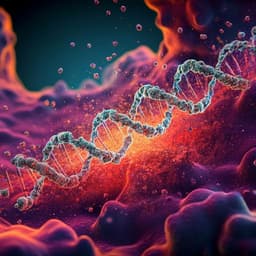
Engineering and Technology
Propagation of extended fractures by local nucleation and rapid transverse expansion of crack-front distortion
T. Cochard, I. Svetlizky, et al.
This groundbreaking research conducted by T. Cochard, I. Svetlizky, G. Albertini, R. C. Viesca, S. M. Rubinstein, F. Spaepen, C. Yuan, M. Denolle, Y.-Q. Song, L. Xiao, and D. A. Weitz unravels the complex dynamics of three-dimensional fracture propagation, revealing exhilarating insights into how localized ruptures can expand rapidly, challenging our understanding of fracture mechanics.
~3 min • Beginner • English
Introduction
The study investigates how extended, three-dimensional fracture fronts initiate and propagate, addressing limitations of two-dimensional approximations that treat the fracture front as a point. In 3D, any in-plane or out-of-plane distortion of a crack front alters near-tip stress singularities and dynamics, potentially imprinting complex morphologies. The research question is how an extended crack advances in realistic 3D settings and what role transverse (along-front) dynamics play. The authors hypothesize that fracture advance proceeds by localized nucleation of rupture that rapidly spreads transversely along the front, strongly influencing forward (radial) propagation and arrest. Establishing this mechanism is important for understanding fracture across scales, from engineered materials and glasses to geological fractures and earthquakes.
Literature Review
Classical 2D fracture mechanics provides universal near-tip stress singularities and energy balance criteria governing onset and propagation. However, extended cracks in 3D can exhibit complex front distortions. During quasi-static propagation, material heterogeneities can pin fronts, leading to intermittent advance. At higher speeds, inertia mediates long-range interactions along the front and supports rapidly propagating crack-front waves triggered by local asperities. Post-mortem and dynamic studies have revealed microbranching, helical instabilities, and nonlinear focusing in dynamic crack fronts, highlighting the importance of 3D effects. Atomistic and lattice models suggest energetically favorable crack advance via localized bond rupture and lateral motion of kinks along the front rather than uniform advance. For fluid-driven cracks, asymptotic and experimental studies have characterized penny-shaped fractures and fluid-lag effects, but direct, time-resolved observation of 3D front dynamics under controlled lag has been lacking. This work bridges these areas by direct high-speed imaging of an extended front with tunable fluid lag and by dynamic simulations capturing transverse distortions.
Methodology
Experimental setup: The authors used a transparent, stereolithographically 3D-printed PMMA-based resin cylinder (diameter 10 cm, height 3.2 cm) to visualize a penny-shaped crack. A central hollow injector (3.8 mm diameter, 16 mm height) opened into a conical initiation site (15 mm diameter, 3 mm height). A small notch seeded fracture. Fluids: water–glycerol mixtures with viscosities from 1 cP (water) up to 400 cP. Injection was at 0.3 ml/min using a high-pressure syringe pump; pressure was monitored (100 ms response). Pressure ramped linearly for ~250 s to ~40 MPa, triggering crack initiation followed by a sudden pressure drop; complete fracture propagation occurred so rapidly that additional injected volume from the pump was negligible. Imaging: A high-speed camera recorded 500×500 px at 100,000 fps. Fluid was dyed with fluorescein and illuminated with a blue LED ring for contrast. Image processing: Pre-fracture images were subtracted from subsequent frames to isolate advancing crack (bright ring) and fluid (darker inner circle). Kymographs along fixed radial directions tracked front positions versus time.
Controlled loading via fluid lag: Increasing viscosity increased the lag λ = R − R_f between the crack front and pressurized fluid front, allowing separation of applied stress location and crack tip.
Measured quantities: • Fluid and fracture front positions vs time; • Stick-break dynamics characterized by jump length δl and inter-event stick times; • Lag Δ (λ) versus time and viscosity; • Radial and transverse velocities; • Correlation between δl and λ; • Transverse propagation times around the circumference.
Material properties: Quasi-static: density 1200 kg/m^3; E = 1.6 GPa; fracture toughness K ≈ 0.75 MPa·m^1/2 (ASTM tests). Dynamic elastic moduli from acoustic tests on a separate block: C_p ≈ 2300 m/s, C_s ≈ 1000 m/s, Rayleigh-wave speed C_R ≈ 940 m/s, ν ≈ 0.38, dynamic E ≈ 3.3 GPa.
Injection system compliance: Total compliance U measured; dominant contribution from water compressibility (≈70% of U). Characteristic length (UE')^1/2 ≈ 4.7 cm comparable to sample radius, indicating fracture propagation is driven by fluid expansion and system compliance rather than continuous injection during fast events.
Modeling with LEFM: A circularly symmetric penny-shaped crack model related K to pressure profile P(r) = P0(1 − r/R) integrated over the fluid-filled region. During rapid jumps, the fluid front was assumed stationary. Nucleation assumed at K_c + δK and arrest at K_c; with δK/K_c ≈ 0.12, predicted δl(λ) and its dependence on viscosity through coupling Poiseuille flow with near-tip opening scaling w(r) ∝ √(R − r). This yielded λ/R as a function of μ, average fluid front velocity v ≈ 3 m/s, and dynamic E' ≈ 3.8 GPa; K at high frequency taken as 1 MPa·m^1/2.
Dynamic rupture simulations: 3D spectral boundary integral method (Uguca) modeled a planar crack with a cohesive zone (size X_c ≈ 200 μm) to regularize the tip singularity. The initial crack front was straight with applied constant pressure beyond a fixed lag distance λ, producing an unstable equilibrium at half-length R with toughness K + δK, reduced to K ahead of the front. Localized toughness reduction nucleated rupture. Simulations used material parameters matching experiments, neglected viscous dissipation, and imposed periodic boundaries tangential to the crack plane. Output included fracture-front profiles, radial and transverse velocities, and dependence on λ and δl.
Key Findings
- Stick-break instability: The fracture front advances discontinuously with long pauses (stick) and rapid forward jumps (break), while the fluid front advances continuously. Average radial velocities of the fronts are similar (~3 m/s), but instantaneous fracture speeds during breaks exceed spatiotemporal resolution, with lower bounds ≥500 m/s for δl up to 5 mm.
- Fluid–fracture lag control: Increasing fluid viscosity increases the lag Δ (λ) between fluid and crack fronts. The measured λ increases with μ, in agreement with the LEFM-flow model.
- Jump amplitude–lag correlation: The jump length δl correlates strongly with λ; larger lag produces larger jumps. Modeling with initiation at K_c + δK and arrest at K_c, with δK/K_c ≈12%, quantitatively reproduces δl(λ).
- Transverse dynamics dominate: Each break nucleates at a localized point on the front and then rapidly expands transversely along the circumference. A single event propagated around half the perimeter (~9 cm) in ~100 μs, giving V_t ≈ 900 m/s, comparable to C_R ≈ 940 m/s.
- Velocity regimes: For δl ≥ 2 mm, transverse velocity V_t is nearly C_R; as δl → 0, V_t drops sharply. Radial motion shows a rapid initial jump followed by strong deceleration.
- Simulations: Dynamic rupture simulations reproduce the observed front shapes and radial velocity history, and predict transverse velocities asymptotically approaching C_R for δl ≥ 2 mm. However, simulations do not capture the experimental decrease of V_t at very small δl, suggesting limitations of the brittle fracture framework or the need to include explicit fluid coupling at short scales comparable to the cohesive zone.
- Multiple nucleation events at small lag: As lag decreases, inter-event stick times shorten and multiple nucleation events occur before a transverse front can traverse half the circumference. Counter-propagating fronts merge and stop; when propagation times greatly exceed stick times, trains of unidirectional transverse fronts are observed.
Discussion
The results demonstrate that extended fracture propagation in 3D is not a uniform advance but proceeds via localized nucleation followed by rapid transverse spreading of crack-front distortions at near-Rayleigh speeds. This mechanism explains discontinuous forward motion (stick-break) and the observed correlation between jump amplitude and fluid–fracture lag under fluid-driven loading. The LEFM-based model with initiation–arrest asymmetry explains how decreasing K with increasing lag sets jump size, while viscous flow in the fracture sets the lag as a function of viscosity. Dynamic simulations confirm that high transverse velocity is essential to capture the observed dynamics and front morphology, underscoring that along-front wave-mediated interactions govern advance in extended cracks. The findings generalize to fractures across scales, including crystalline materials where kink nucleation and lateral advance have been predicted, and to geophysical settings where microearthquakes suggest localized propagation distributed along fronts. The observed multiplicity and interaction of transverse fronts at lower lag provide a framework for understanding complex spatiotemporal patterns in fracture propagation beyond 2D approximations.
Conclusion
This work establishes that extended fractures propagate by local nucleation events that trigger rapid transverse expansion of crack-front distortions at near-Rayleigh speeds, which then drive the net forward advance. By combining a circular geometry without edges, fluid-driven loading to tune lag, high-speed imaging, LEFM modeling, and dynamic rupture simulations, the study quantifies the link between lag, jump amplitude, and transverse velocity, and reveals a stick-break instability intrinsic to fluid-driven fracture. The results highlight the central role of transverse dynamics in 3D fracture and provide a unified picture relevant from engineered materials to geological fractures. Future research should (i) directly measure cohesive-zone lengths and high-frequency fracture energy, (ii) incorporate explicit fluid–structure coupling at short length scales to capture small-jump transverse velocity reductions, (iii) explore other materials (including crystalline solids) to test kink-mediated advance, and (iv) investigate how heterogeneities and boundary geometries modulate nucleation statistics and transverse wave dynamics.
Limitations
- Spatial and temporal resolution limits: The lower bound on instantaneous forward velocity and minimum measurable jump δλ (~<200 μm for water) are constrained by imaging resolution and frame rate. Pressure sensor response (100 ms) cannot resolve rapid transients.
- Modeling assumptions: LEFM model assumes circular symmetry and a stationary fluid front during jumps; actual fronts exhibit local distortions. The pressure profile approximation and neglect of vapor pressure in the lag introduce simplifications.
- Simulation framework: Brittle fracture with a fixed cohesive zone and no explicit fluid coupling captures dynamics for larger jumps but not the reduced transverse velocity at very small δl; results may depend on the cohesive-zone scale relative to jump length.
- Material specificity: Experiments use 3D-printed PMMA in a circular geometry; generalization to other materials and geometries (with edges or heterogeneities) requires further validation.
- Frequency-dependent properties: Dynamic E is measured acoustically, but the corresponding high-frequency toughness K was not directly measured and was set for modeling, introducing uncertainty.
Related Publications
Explore these studies to deepen your understanding of the subject.







